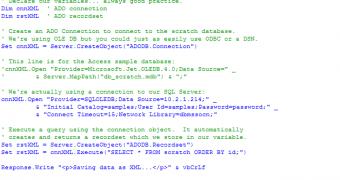Most of the websites are created from static documents and image files. If you want to create an advanced website with forms handling, dynamically generated pages, shopping carts, content management systems, databases, and so on, you should learn a server-side programming language. The main difference between client-side and server-side programming is that client-side scripts are downloaded, interpreted and executed by the browser and the server-side scripts run on a server.
The scripting and programming languages that are used to create server-side applications are: ASP, ASP.NET, PHP, JSP, ColdFusion, Ruby on Rails and more.
Asp (Active Server Pages) is a server-side scripting language created by Microsoft. Microsoft marketed ASP as an add on for IIS. Using Apache-asp you can port asp pages to Apache with Perl scripting only. An ASP file normally contains HTML tags, just like an HTML file. However, an ASP file can also contain server scripts, surrounded by the delimiters . Server scripts are executed on the server, and can contain any expressions, statements, procedures, or operators valid for the scripting language you prefer to use.
ASP.NET is part of Microsoft .NET platform. ASP.NET simplifies the transition from windows application development to web development and offers the ability to build web applications using controls similar to windows applications.
PHP is a widely-used general-purpose scripting language that is especially suited for Web development and can be embedded into HTML. The main advantage of PHP is that it is very easy to understand by a beginner and offers many advanced features for a professional developer. Another advantage is that it can be used on all major operating systems: Windows, Linux, BSD, Mac etc. The most significant feature in PHP is its support for a wide range of databases.
JSP (Java Server Page) is an extension of the Java Servlet technology. A JavaServer Page contains the following things: static data such as HTML, JSP directives such as the include directive, JSP scripting elements and variables, JSP actions and custom tags with correct library.
Ruby on Rails is an open source Ruby framework for developing web-based, database-driven applications. Ruby on Rails divides itself into various packages, namely Active Record, Action Pack, Active Support, Action Mailer and Action Web Service. In addition, Developers can create plugins to extend existing packages.

 14 DAY TRIAL //
14 DAY TRIAL //